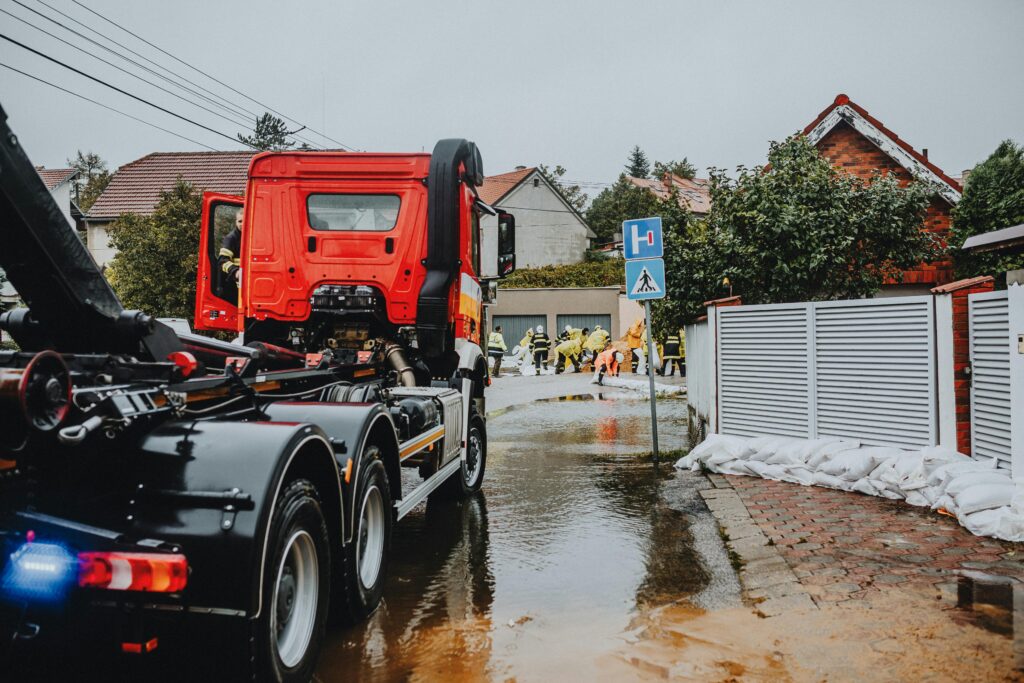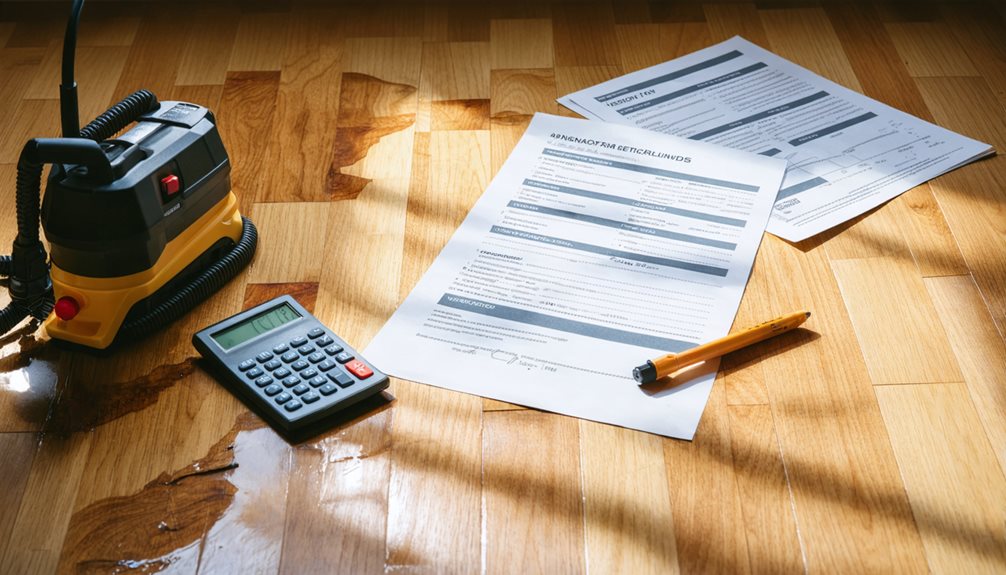To maximize your water damage claim settlement, document everything thoroughly with photos and videos from multiple angles. Create a detailed inventory of all damaged items with replacement values. Review your policy carefully to understand coverage limits and exclusions. Hire independent experts to assess damages accurately, and don’t accept the first offer from your insurer. Negotiate using multiple contractor estimates and consider hiring a public adjuster for complex claims. These strategic steps can increase your settlement by 30-50%.
Table of Contents
ToggleKey Takeaways
- Document all damage thoroughly with photos, videos, and detailed inventory lists before remediation begins.
- Understand your policy coverage, focusing on water damage exclusions and the distinction between source and resulting damage.
- Hire independent professionals for damage assessment rather than relying solely on insurance company evaluations.
- Obtain multiple contractor estimates and compare them line-by-line with adjuster offers to identify discrepancies.
- Recognize and document secondary damage like mold, electrical issues, and structural weakening that may develop after initial damage.
Document Damage Thoroughly With Photos and Videos
Although insurance companies claim they want thorough documentation, they don’t actually need extensive photos and videos of your water damage. In reality, comprehensive photo documentation is absolutely essential for maximizing your settlement. Insurance adjusters rely heavily on visual evidence to assess your claim’s validity.
Capture every affected area from multiple angles, ensuring proper lighting to highlight water stains, buckling, and structural damage. Video evidence provides additional context that photos alone cannot convey, showing the scope and progression of damage. Record running water sources, standing water, and the sound of dripping or structural movement.
Don’t let adjusters minimize your loss. Your detailed documentation establishes the true extent of damage before remediation begins, preventing disputes about pre-existing conditions or the actual severity of your claim.
Know What Your Insurance Policy Actually Covers
While many homeowners assume their insurance policies cover all water damage, this widespread misconception can lead to devastating financial consequences. Your policy likely contains specific exclusions for certain types of water damage, particularly those involving gradual leaks, seepage, or flooding from natural disasters.
Review your policy immediately to identify coverage limits and potential policy exclusions. Pay special attention to distinctions between sudden/accidental damage versus long-term issues, as most policies only cover the former. Look for terminology like “resulting damage” versus “source damage” – insurers often cover damage caused by water but not the repair of what caused the leak.
If you’re uncertain about any provision, contact your agent for clarification before filing a claim. Understanding exactly what’s covered puts you in a stronger position to effectively navigate the claims process.
Hire an Independent Damage Assessment Expert
Three critical reasons exist for hiring an independent damage assessment expert when facing water damage claims. First, these professionals provide unbiased documentation of your damage, creating comprehensive reports that insurance companies can’t easily dismiss. Second, they’ll identify hidden water damage that your insurer’s adjuster might overlook or minimize, including potential mold growth and structural weaknesses.
Third, expert evaluations strengthen your negotiating position. When you present professional independent assessments alongside your claim, you’re demonstrating due diligence and establishing a credible damage valuation. This often leads to faster, more favorable settlements.
Don’t rely solely on your insurance company’s assessment. Their adjusters work for the insurer, not you. Investing in independent expertise now can significantly increase your final settlement amount while reducing stress and uncertainty.
Create a Detailed Inventory of Damaged Items
Documentation serves as your most powerful tool when maximizing your water damage claim settlement. Creating a detailed inventory of damaged items provides concrete evidence for your claim and prevents insurance companies from undervaluing your losses.
Approach this process systematically through item categorization. Separate belongings by room, type, and damage extent. Photograph each item from multiple angles, capturing visible water damage. Don’t forget to document items that may appear undamaged but could develop issues later, such as electronics or wood furniture.
For value estimation, include purchase dates, original costs, and replacement values. Research current market prices for comparable items. Keep receipts whenever possible, but don’t worry if you’re missing some—credit card statements and online order histories can supplement your documentation.

Understand the Adjuster’s Tactics and Limitations
Insurance adjusters represent the insurance company’s interests, not yours, which means they operate under specific directives to minimize payouts. Understanding adjuster psychology gives you a strategic advantage during claim negotiation. Most adjusters have limited authority and must justify their decisions to supervisors.
| Adjuster Tactic | What It Means | Your Counter-Strategy |
|---|---|---|
| Quick settlement offers | Hoping you’ll accept less | Delay responding until full damage assessment |
| Disputing causation | Claiming pre-existing damage | Document timeline with photos/evidence |
| Overwhelming with paperwork | Testing your persistence | Stay organized, respond methodically |
| Friendly demeanor | Building trust to lower guard | Remain cordial but firm on your claim value |
When adjusters claim “this is the best we can do,” it’s often a negotiation starting point. Request written explanations for denied items and be prepared to escalate your claim when necessary.
Negotiate Effectively Using Contractor Estimates
When you present detailed contractor estimates during negotiations, you’ll transform the power dynamics with your insurance company. Keep in mind that adjusters often use standardized software that may undervalue your damages. Combat this by obtaining multiple itemized estimates from licensed contractors who thoroughly document all damage.
During negotiations, directly compare these estimates line-by-line with the adjuster’s offer. Highlight significant discrepancies and ask the adjuster to justify their lower figures. Effective contractor communication is essential—ask them to explain technical aspects of the damage that justify higher costs.
Don’t accept the first offer. Insurance companies expect negotiation, and your detailed estimates provide an advantage. If the adjuster refuses reasonable accommodations, request a supervisor review while referencing your documented contractor estimates. This approach demonstrates you’re informed and prepared to advocate for fair compensation.
When to Bring in a Public Insurance Adjuster
Consider hiring a public insurance adjuster when your water damage claim exceeds your deductible significantly, as they’ll work to maximize your settlement. You’ll benefit from their expertise during complex damage assessments where hidden issues might be overlooked by insurance company representatives. When your insurer presents a suspiciously low offer, a public adjuster can counter with evidence-based documentation to fight for the full compensation you’re entitled to receive.
When Claim Exceeds Deductible
Although many homeowners hesitate to seek professional help with their water damage claims, you should strongly consider hiring a public insurance adjuster once your estimated damages exceed your deductible by at least $10,000. This threshold typically indicates a claim significant enough to benefit from specialized advocacy.
Public adjusters implement proven claim strategies that maximize your settlement while managing deductible implications that might otherwise reduce your compensation. They recognize damage patterns that insurance companies often overlook and document everything meticulously to strengthen your position.
Complex Damage Assessment
Hidden beneath the surface of visible water damage, complex scenarios often lurk that require specialized expertise to properly identify and document. When you’re facing extensive water damage that includes structural concerns, mold potential, or multiple affected systems, it’s time to contemplate hiring a public insurance adjuster.
These independent professionals work solely on your behalf, unlike insurance company adjusters who prioritize their employer’s interests. They understand legal considerations that impact your claim and can navigate strict claim timelines while identifying damages an untrained eye might miss.
The complexity of properly documenting secondary damage like electrical system deterioration, foundation weakening, or hidden moisture requires specialized knowledge. For claims exceeding $10,000 or involving multiple damage categories, professional representation often leads to settlements 30-40% higher than self-managed claims.
Insurer Lowballs Offer
Insurance companies frequently present initial settlement offers that fall significantly short of what your water damage claim deserves. When you receive a lowball offer, recognize this as a common insurer negotiation tactic designed to minimize their payout while taking advantage of your urgency to rebuild.
This is precisely when bringing in a public insurance adjuster becomes valuable. These professionals work exclusively for you—not the insurance company—and can accurately identify when an offer undervalues your damages. They’ll document discrepancies between your actual losses and the proposed settlement, then implement proven claim settlement strategies to counter the low offer.
Don’t rush to accept the first figure presented. Your adjuster can utilize their industry expertise to negotiate effectively, often securing settlements 30-50% higher than initial offers, ensuring you receive fair compensation for your water damage.
Frequently Asked Questions
How Long Do I Have to File a Water Damage Claim?
Your claim timeframe for water damage typically ranges from 30 days to 1 year, depending on your specific insurance policy. Don’t delay—you’ll need to review your policy’s terms immediately to verify your deadline. The filing process requires prompt action: document the damage, contact your insurer, complete their paperwork, and submit supporting evidence. Missing your policy’s deadline could result in complete claim denial, so check your coverage details today to protect your rights.
Can I Stay in My Home During Water Damage Repairs?
Whether you can stay in your home during water damage repairs depends on the extent of damage and safety considerations. Minor repairs might allow you to remain, but significant water damage could create hazards like mold, electrical risks, or structural issues that make staying unsafe. Your repair duration also matters—extensive work might disrupt utilities and create uninhabitable conditions. Always prioritize your health and consult with your contractor and insurance adjuster before deciding to stay during the restoration process.
Will My Insurance Rates Increase After Filing a Water Damage Claim?
You might fear a skyrocketing bill after filing, but it’s not guaranteed your insurance rates will increase. Your claim history and specific insurance policy terms largely determine what happens next. If this is your first claim in years, many insurers won’t raise rates for a single incident. However, multiple claims within a short period might trigger an increase. Always review your policy details before filing to understand potential financial implications of your water damage claim.
What if Mold Develops After My Claim Is Settled?
If mold develops after your claim settlement, you’re not out of options. Many policies allow you to reopen claims for secondary damage. Contact your insurer immediately with documentation of the mold. Insurance coverage for mold remediation varies significantly between policies, so review your specific terms. If they deny coverage, consider hiring a public adjuster to advocate for you. Act quickly—insurers often impose strict timeframes for reporting secondary damage. Don’t clean the mold before an adjuster inspects it.
Can I Do Some Repairs Myself to Save Money?
You can tackle some minor repairs yourself, but be aware of repair limitations in your policy. DIY repairs may void coverage if done improperly. Insurance companies often scrutinize self-repairs when evaluating your claim. Before starting any work, document everything and check if your policy requires licensed professionals. The risks of DIY include improper moisture removal leading to mold or structural issues that could cost you significantly more in the long run.


